
Mountaineering, mountain climbing, or alpinism is a set of outdoor activities that involves ascending mountains. Mountaineering-related activities include traditional outdoor climbing, skiing, and traversing via ferratas that have become sports in their own right. Indoor climbing, sport climbing, and bouldering are also considered variants of mountaineering by some, but are part of a wide group of mountain sports.
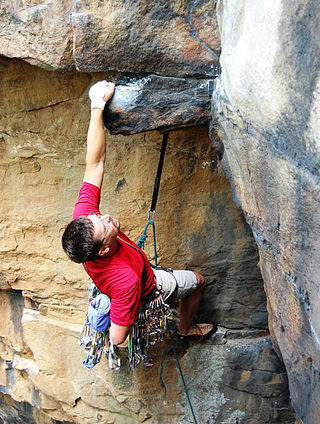
Traditional climbing is a type of free climbing in rock climbing where the lead climber places the protection equipment while ascending the route; when the lead climber has completed the route, the second climber then removes the protection equipment as they climb the route. Traditional climbing differs from sport climbing where the protection equipment is pre-drilled into the rock in the form of bolts.

A climbing harness is a device which allows a climber access to the safety of a rope. It is used in rock and ice climbing, abseiling, and lowering; this is in contrast to other activities requiring ropes for access or safety such as industrial rope work, construction, and rescue and recovery, which use safety harnesses instead.

Glossary of climbing terms relates to rock climbing, mountaineering, and to ice climbing.

Ice climbing is a climbing discipline that involves ascending routes consisting of frozen water. To ascend the route, the ice climber uses specialist equipment, particularly double ice axes and rigid crampons. To protect the route, the ice climber uses steel ice screws that require skill to employ safely and rely on the ice holding firm in any fall. Ice climbing routes can vary significantly by type, and include seasonally frozen waterfalls, high permanently frozen alpine couloirs, and large hanging icicles.

Rock-climbing equipment varies with the type of climbing undertaken. Bouldering needs the least equipment outside of shoes and chalk and optional crash pads. Sport climbing adds ropes, harnesses, belay devices, and quickdraws to clip into pre-drilled bolts. Traditional climbing adds the need for carrying a "rack" of temporary passive and active protection devices. Multi-pitch climbing adds devices to assist in ascending and descending fixed ropes. And finally aid climbing uses unique equipment.

Abseiling, also known as rappelling, is the controlled descent of a steep slope, such as a rock face, by moving down a rope. When abseiling, the person descending controls his own movement down a static or fixed rope, in contrast to lowering off, in which the rope attached to the person descending is paid out by his belayer.

Solo climbing, or soloing, is a style of climbing in which the climber climbs a route alone, without the assistance of a belayer. By its very nature, it presents a higher degree of risk to the climber, and in some cases, is considered extremely high risk. Note that the use of the term "solo climbing" is generally separate from the action of bouldering, which is itself a form of solo climbing, but with less serious consequences in the case of a fall. The most dangerous form of solo climbing is free solo climbing, which means both climbing alone and without any form of climbing protection.
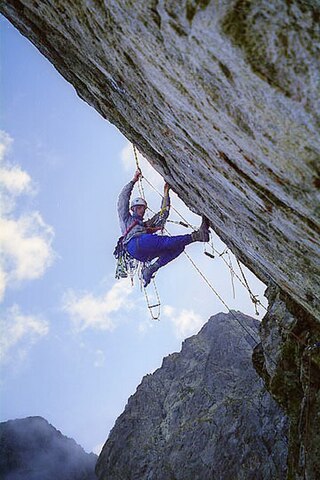
Aid climbing is a form of rock climbing that uses mechanical devices and equipment, such as aiders, for upward momentum. Aid climbing is different than free climbing, which only uses mechanical equipment for protection, but not to assist in upward momentum. "Aid climbing" sometimes involves hammering in pitons and bolts, into which aiders are clipped, but there is also "clean aid climbing" which avoids hammering, using only removable placements.

In climbing and mountaineering, the term belaying refers to techniques used to create friction within a climbing protection system, particularly on a climbing rope, so that a falling climber does not fall very far. A climbing partner typically applies tension at the other end of the rope whenever the climber is not moving, and removes the tension from the rope whenever the climber needs more rope to continue climbing. The belay is the place where the belayer is anchored, which is typically on the ground, or on ledge but may also be a hanging belay where the belayer themself is suspended from an anchor in the rock on a multi-pitch climb.
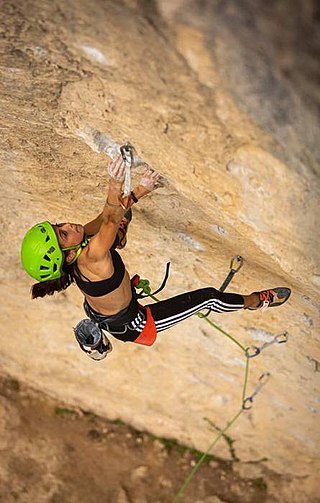
Lead climbing is a technique in rock climbing where the lead climber clips their rope to the climbing protection as they ascend a pitch of the climbing route, while their second remains at the base of the route belaying the rope to protect the lead climber in the event that they fall. The term is used to distinguish between the two roles, and the greater effort and increased risk, of the role of the lead climber.
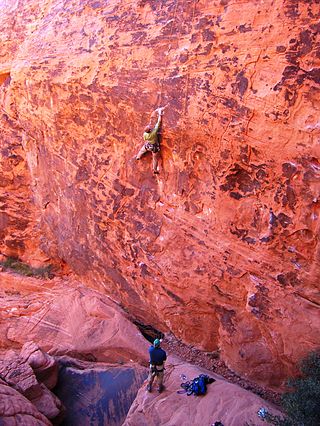
Top rope climbing is a form of rock climbing where the climber is securely attached to a climbing rope that runs through a fixed anchor at the top of the climbing route, and back down to the belayer at the base of the climb. A climber who falls will just hang from the rope at the point of the fall, and can then either resume their climb or have the belayer lower them down in a controlled manner to the base of the climb. Climbers on indoor climbing walls can use mechanical auto belay devices to top rope alone.
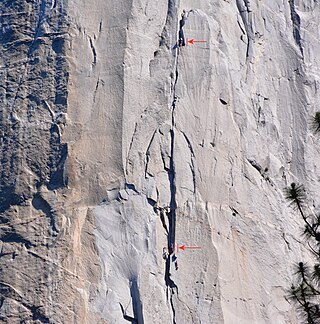
In climbing, a pitch is a section of a climbing route between two belay points, and is most commonly related to the task of lead climbing, but is also related to abseiling. Climbing on routes that require only one pitch is known as single-pitch climbing, and climbing on routes with more than one pitch is known as multi-pitch climbing.

Rock climbing is a sport in which participants climb up, across, or down natural rock formations or indoor climbing walls. The goal is to reach the summit of a formation or the endpoint of a usually pre-defined route without falling. Rock climbing is a physically and mentally demanding sport, one that often tests a climber's strength, endurance, agility and balance along with mental control. Knowledge of proper climbing techniques and the use of specialized climbing equipment is crucial for the safe completion of routes.

Multi-pitch climbing is a type of climbing that typically takes place on routes that are more than a single rope length in height, and thus where the lead climber cannot complete the climb as a single pitch. Where the number of pitches exceeds 6–10, it can become big wall climbing, or where the pitches are in a mixed rock and ice mountain environment, it can become alpine climbing. Multi-pitch rock climbs can come in traditional, sport, and aid formats. Some have free soloed multi-pitch routes.
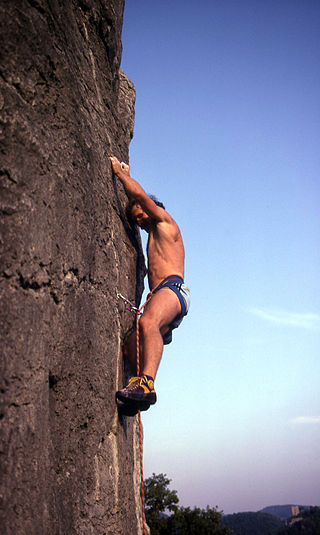
In rock climbing, redpointing means to free-climb a route from the ground to the top while lead climbing, after having practiced the route or after having failed first attempt. Climbers will try to redpoint a route after having failed to onsight it, or flash it. The first successful redpoint of a route, in the absence of any prior onsight or flash, is recorded as the first free ascent (FFA) of that route.
In rock climbing, an anchor can be any device or method for attaching a climber, rope, or load to a climbing surface—typically rock, ice, steep dirt, or a building—either permanently or temporarily. The intention of an anchor is case-specific but is usually for fall protection, primarily fall arrest and fall restraint. Climbing anchors are also used for hoisting, holding static loads, or redirecting a rope.

Rope-solo climbing or rope-soloing is a form of solo climbing, but unlike with free solo climbing, which is also performed alone and with no climbing protection whatsoever, the rope-solo climber uses a mechanical self-belay device and rope system, which enables them to use the standard climbing protection to protect themselves in the event of a fall.

A dynamic rope is a specially constructed, somewhat elastic rope used primarily in rock climbing, ice climbing, and mountaineering. This elasticity, or stretch, is the property that makes the rope dynamic—in contrast to a static rope that has only slight elongation under load. Greater elasticity allows a dynamic rope to more slowly absorb the energy of a sudden load, such from arresting a climber's fall, by reducing the peak force on the rope and thus the probability of the rope's catastrophic failure. A kernmantle rope is the most common type of dynamic rope now used. Since 1945, nylon has, because of its superior durability and strength, replaced all natural materials in climbing rope.

A belay device is a mechanical piece of climbing equipment used to control a rope during belaying. It is designed to improve belay safety for the climber by allowing the belayer to manage their duties with minimal physical effort. With the right belay device, a small, weak climber can easily arrest the fall of a much heavier partner. Belay devices act as a friction brake, so that when a climber falls with any slack in the rope, the fall is brought to a stop.




















